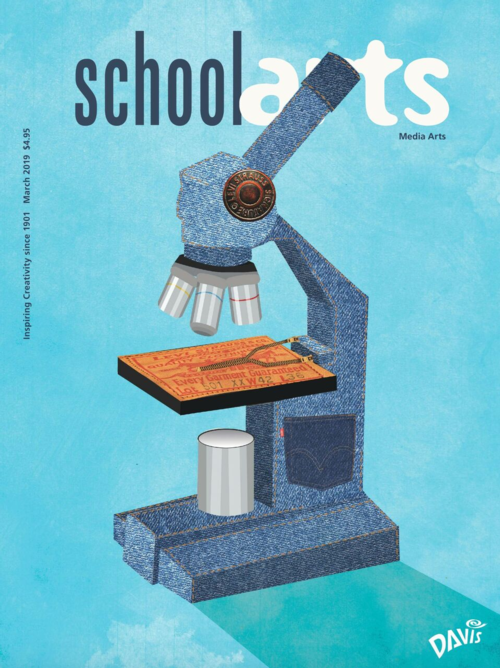
A digital portrait of Nancy Walkup by Kasmira Mohanty, art teacher at Huntington High School in Huntington, New York. Her students’ work is featured in the article Frankenstein Design (page 21) and on the cover of this issue.
This 2014 revision of the 1994 standards includes media arts as a fifth arts discipline along with dance, music, theater, and visual arts.
The standards define media arts as “a unique medium of artistic expression that can amplify and integrate the four traditional art forms by incorporating the technological advances of the contemporary world with emerging skill sets available to students and teachers. The media artist utilizes a fundamental understanding of the mediums of analog and digital media to integrate digital technologies with traditional forms of artistic expression.”
Similarly, the National Endowment for the Arts (NEA) defines media arts as “all genres and forms that use electronic media, film, and technology (analog and digital) as an artistic medium or a medium to broaden arts appreciation and awareness of any discipline. This includes projects presented via film, television, radio, audio, video, the internet, interactive and mobile technologies, video games, immersive and multi-platform storytelling, and satellite streaming.”
Bringing media arts into the classroom can present a challenge for teachers because many of us are digital immigrants, not natives. According to Marc Prensky, author of a 2001 article, “Digital Natives, Digital Immigrants,” a digital immigrant is someone who was not born into the digital world. I am a prime example. I can remember rotary phones, filmstrips, overhead projectors, and the first time someone showed me a web browser. My first computer was a Macintosh Classic (which I still have).
Prensky contends that the single biggest problem facing education today is that “our DI instructors, who speak an outdated language (that of the predigital age) are struggling to teach a population that speaks an entirely new language.” Our students today are digital natives who represent the first students to grow up with cell phones, computers, video games, tablets, digital cameras, webcams, email, the internet, instant messaging, social media, and other forms of ever-evolving technology. There is no time in their lives that this technology didn’t exist. And we can’t even imagine what advances will be made in technology during our students’ lives.
So, how can digital immigrant teachers reach students who expect connectivity and instantaneity in all media? Prensky advises digital immigrants to accept that we need to learn to communicate in the language of our digital native students, adapting materials to their language.
As art teachers, we need to learn as much as we can of the new digital language, accept help from our students to do so, and look for ways to utilize digital technology for learning and creating in media art.
To do our part, SchoolArts is publishing SchoolArts Collection: Media Arts, available March 2019 from Davis Publications. In it we have compiled media arts articles from SchoolArts written by the best art teachers in the business of teaching media arts and new technologies. Whether you are a digital immigrant or a digital native, these approaches will give you a wealth of ideas for using media arts in your classroom.
Email Nancy at NWalkup@DavisArt.com
View this article in the digital edition.



